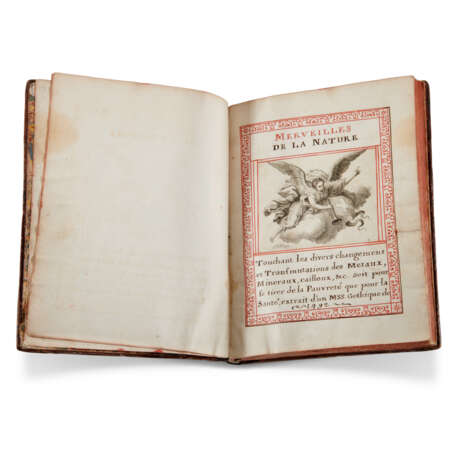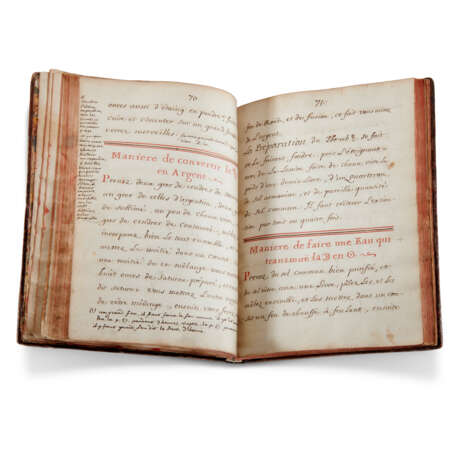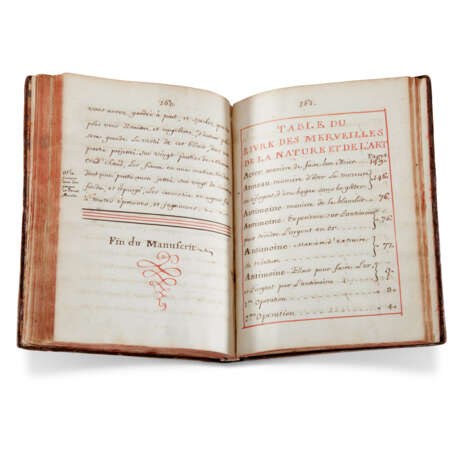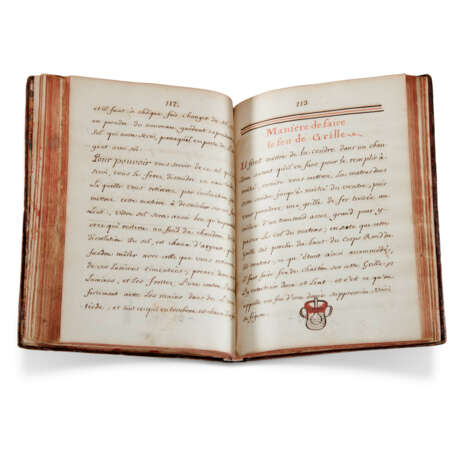ID 1105648
Lot 41 | Anonymous French alchemist
Estimate value
£ 4 000 – 6 000
Merveilles de la Nature, in French, decorated manuscript on paper [France, 18th century]
A fascinating exploration of the Alchemical Process, the transmutation of metals, etc., apparently drawn from a 1492 manuscript exemplar.
229 x 172mm. iii + 88 + iv leaves, complete, contemporary pagination 1-175 followed here, c.16 lines written in a clear 18th-century French hand, engraved vignette with a trumpeting angel by N. Pitau added to title-page, headings in red, one diagram of an alchemical process on p.113, index framed in red (light marginal thumbing and occasional stains). Contemporary calf, spine gilt (a little scuffed).
Provenance:
'Vendu a la vente G. * * *' and 'ouvrage tres curieux', along with an erased inscription in French on front flyleaf.
Content: Merveilles de la Nature, touchant les divers changemens et Transmutations des Metaux, Mineraux, Cailloux, &c. soit pour se tirer de la Pauvreté que pour la Santé, extrait d'un MSS Gothique de 1492 f.1, Preface pp.1-2; various alchemical processes, including: an 'Elixir pour or ou pour Argent fait par l'Antimoine, ou par l'Orpiment' (p.3); seven multiplications, i.e. the processes used to increase the potency of the philosopher's stone, elixir or projection powder (pp.16-23); a recipe for perfect health which if misused can result in death (p.24); instructions on how to produce precious gemstones, diamonds and rubies (pp.30-33); a method to transform all metals that contain mercury into liquid mercury (p.33); fixation (or the process in alchemy whereby a volatile substance is transformed into a solid) of silver (pp.35-41); a 'secret' method to convert silver into gold, according to a M. Lorry whose ring was made in such a manner as was - apparently - the 'Calice de St Denys en France' (p.41); a recipe for potable gold (p.42, with another on p.55); various other methods of fixation, calcination and dissolution (pp.49-55); a method for extracting gold from leather (p.58); other instructions for transmutations of metals; instructions to produce 'feu de grille', with accompanying drawing (p.113); other methods of fixation; Table of Contents (pp.161-175).
The conceit that the manuscript is drawn from a 15th-century exemplar is continued in the Table of Contents at the end, where the author says on p.162 that his method for the fixation of silver has been tried and tested and is based on a recipe he came up with in 1489 when he worked with Messers Jean and Martin Pisans. With it they were earning a thousand ducats a week, but the secret of the recipe cost them 'des grosses sommes [...], beaucoup de peine, soins, veilles, et travail'. Its source was apparently a man who died with a fortune of more than twelve million.
| Address of auction |
CHRISTIE'S 8 King Street, St. James's SW1Y 6QT London United Kingdom | ||||
|---|---|---|---|---|---|
| Preview |
| ||||
| Phone | +44 (0)20 7839 9060 | ||||
| Buyer Premium | see on Website | ||||
| Conditions of purchase | Conditions of purchase |






